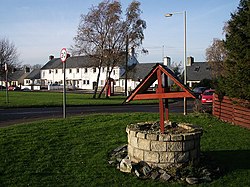Aberargie: Difference between revisions
Created page with "{{Infobox town |county=Perth |gaelic=Obar Fhargaidh |picture=Aberargie - geograph.org.uk - 81697.jpg |picture caption=Nethermill Cottages, Aberargie |os grid ref=NO163158 |lat..." |
m →Origin and History: clean up, replaced: Medieval → mediæval |
||
| Line 17: | Line 17: | ||
Aberargie is recorded in the Pictish Chronicle as part of Nechtan's land grant in AD 460, and may have been in existence for much longer. Aberargies' place in most history books is as a small part of the bigger Parish of Abernethy, but there was at one time a thriving community, based on the utilisation of the River Farg to power water mills for various purposes from sawing timber to the milling of flax and meal. Mills have been recorded at Pottie, part of which still stands at the bottom of the Farg Glen, Ayton Farm, Mill House, Willow Bank, which also has some standing ruins, and Gowlie. The feu duty for most of these mills up until the late 19th century was payable to [[Balmerino Abbey]] Estates. The mills had all ceased production by the early 20th century, and the most complete, at Mill House, was demolished in the 1950s. | Aberargie is recorded in the Pictish Chronicle as part of Nechtan's land grant in AD 460, and may have been in existence for much longer. Aberargies' place in most history books is as a small part of the bigger Parish of Abernethy, but there was at one time a thriving community, based on the utilisation of the River Farg to power water mills for various purposes from sawing timber to the milling of flax and meal. Mills have been recorded at Pottie, part of which still stands at the bottom of the Farg Glen, Ayton Farm, Mill House, Willow Bank, which also has some standing ruins, and Gowlie. The feu duty for most of these mills up until the late 19th century was payable to [[Balmerino Abbey]] Estates. The mills had all ceased production by the early 20th century, and the most complete, at Mill House, was demolished in the 1950s. | ||
Archaeological surface finds from fields in the vicinity of the village range from neolithic flints, to the full range of Scottish | Archaeological surface finds from fields in the vicinity of the village range from neolithic flints, to the full range of Scottish mediæval pottery <ref>http://www.tafac.org.uk/tafaj29.pdf</ref> and flintlock rifle/pistol flints. Further indicating an extensive period of settlement and activity in the area. | ||
==References== | ==References== | ||
Latest revision as of 12:20, 30 January 2021
| Aberargie Gaelic: Obar Fhargaidh | |
| Perthshire | |
|---|---|
 Nethermill Cottages, Aberargie | |
| Location | |
| Grid reference: | NO163158 |
| Location: | 56°19’38"N, 3°21’18"W |
| Data | |
| Post town: | Perth |
| Postcode: | PH2 |
| Dialling code: | 01738 |
| Local Government | |
| Council: | Perth and Kinross |
Aberargie is a village in the parish of Abernethy, Perthshire, on the banks of the River Farg, from which it derives its name. Aberargie is around a mile and a half west of Abernethy, and two miles south-east of Bridge of Earn.
Origin and History
Aberargie is recorded in the Pictish Chronicle as part of Nechtan's land grant in AD 460, and may have been in existence for much longer. Aberargies' place in most history books is as a small part of the bigger Parish of Abernethy, but there was at one time a thriving community, based on the utilisation of the River Farg to power water mills for various purposes from sawing timber to the milling of flax and meal. Mills have been recorded at Pottie, part of which still stands at the bottom of the Farg Glen, Ayton Farm, Mill House, Willow Bank, which also has some standing ruins, and Gowlie. The feu duty for most of these mills up until the late 19th century was payable to Balmerino Abbey Estates. The mills had all ceased production by the early 20th century, and the most complete, at Mill House, was demolished in the 1950s.
Archaeological surface finds from fields in the vicinity of the village range from neolithic flints, to the full range of Scottish mediæval pottery [1] and flintlock rifle/pistol flints. Further indicating an extensive period of settlement and activity in the area.
References
| ("Wikimedia Commons" has material about Aberargie) |
This Perthshire article is a stub: help to improve Wikishire by building it up.
